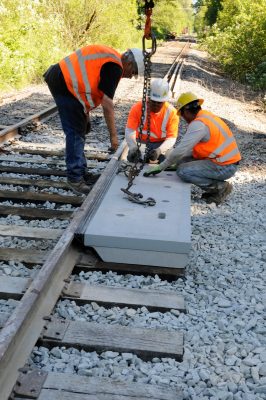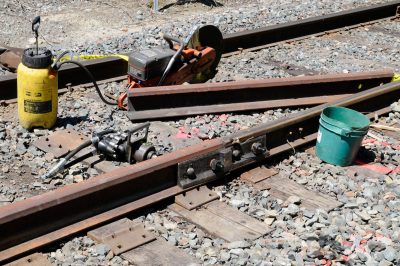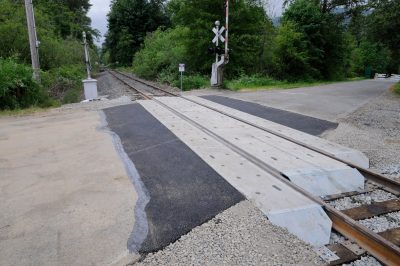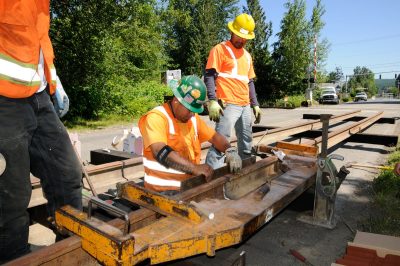Crossings are the interface between a railroad and a roadway or trail. The Northwest Railway Museum has 23 crossings; 13 of those are public crossings of local streets, arterials, or major thoroughfares including a State highway. All of these crossings require ongoing maintenance; the majority of the wear and tear is caused by truck and automobile traffic. To meet the needs of today’s heavier trucks and increased traffic, when it is opportune crossings are being rebuilt to withstand greater weight and use.
Among the busiest of the public crossings in Snoqualmie is Meadowbrook Way SE, a road that opened in the 1920s. It was last reconstructed after the great flood of 1996 using asphalt. The roadway was heavily impacted by flooding in 2007 and again in 2009, and is scheduled for repaving (overlay) in late summer 2011. The Museum has been working with the City of Snoqualmie for more than four years to secure funding that would allow reconstruction of the crossing along with the overlay. Fortunately, a portion of funding from the Snoqualmie Tribe’s Snoqualmie Casino designated for area road improvements has allowed the project to proceed.

New concrete crossing panel is lowered into place. Large lag screws driven into the white oak cross ties will hold them in place.
The Museum has rebuilt nearly 1/2 of its public crossings in the last 15 years. All of the recent projects have been reconstructed using concrete panels similar to those used on railroads throughout the Northwest. These panels last longer and take the weight of today’s trucks better than older-style asphalt or timber crossings. But the concrete panels are only the most obvious element of a crossing reconstruction. Reconstructions also often involve upgrading the size of the rail and improving the subgrade conditions by excavating out the native soil to a depth of 41 inches and replacing it with railroad ballast. (This makes the crossing more resistant to settlement caused by the passage of trucks and busses.) It also involves the use of longer railroad crossties to improve stability and to support concrete panels. All these improvements together allow reconstructed crossings to last at least 25 years.
RailWorks of Chehalis, WA was awarded a contract and began work on July 5. The existing crossing was removed and the subgrade was excavated to a depth of 41 inches. Larger replacement rail (115 RE, which means it is 115 pounds per yard, as opposed to the existing 90 RB rail, which is 90 pounds to the yard) was welded together using the thermite process to eliminate rail joints from the crossing. Geofabric was placed as a new base at the bottom of the excavation. New railroad ballast was placed as subgrade and new oak crossties were placed on 18 inch centers. The welded rail was double spiked in the crossing and rail anchors to resist creep were installed. Concrete panels

Special compromise joint bars transition between the new welded rail and the existing rail. (Note the different height.)
manufactured by Omega Industries of Vancouver, WA were installed on the new ties, and Asphalt by George patched the space between the new panels and the existing roadway. The City of Snoqualmie provided additional project support by assuming responsibility for the temporary closure of Meadowbrook Way SE. Project value was $38,000 and work was completed in 3 days.




Spike, The concrete panels and well thought out repairs/construction of the rail crossings makes lots of sense! Being from Chicago, I've seen repeated repairs, year after year, using asphalt. In the long run, doing it right will save money and lessen public inconvenience. Thanks for the construction lesson! Take Care, Big Daddy Dave